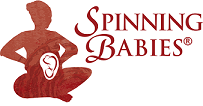Meanwhile, the woman in the previous post (from earlier today) realized her baby had been left occiput posterior (LOP). “His” back had been on her left and his fingers busy in front. The baby rode high and she couldn’t lean forward without discomfort for herself and, she suspected, for her baby. I then felt her baby and agreed the baby was LOP.
I explained the 3 Principles: 1.) Relax what the mother can’t herself relax. 2.) Use gravity to encourage the baby to settle into the front of the abdominal wall. 3.) Use movement to move the pelvis and soft tissues around the baby.
So we began:
1.) Abdominal release, also called a diaphragmatic release.
2.) Sacral release, also called a buckled sacrum release.
3.) She laid down and I stroked the sides of the abdomen, lifting the weight of her womb and wiggling my hands upward, jiggling the broad ligaments. She liked this.
4.) Rebozo “sifting” of the abdomen while she knelt and leaned her arms and head on the bed. Her husband tried this, too, surprised it was such an upper body workout. She smiled and said it was awesome.
By now she had no or little pain, remember she had taken the kali carb. See previous post.
5. ) We ended with a pelvic floor release. That put a stretch in her lower back where the pelvic floor attaches to the back side of the hip bone and sacrum. She did both sides so she didn’t add to the asymmetrical pull of her body.
Her baby was now left occiput transverse (LOT), an excellent start position. Yet there was much amniotic fluid and the baby wasn’t engaging into the pelvic brim yet. So unless her tissues were relaxed more completely so they could become symmetrical, the baby is likely to go back to posterior.
Her plan is to return to the Chiropractor and see what soft tissue work the Chiropractor can do. They can also continue with this list at home. I suggested she wait at least a week before trying another pelvic floor release. She planned to get on an inversion table for 30-60 seconds for a few times to help her lower uterine segment relax and in so doing, become more symmetrical.
Then the baby should be able to stay out of the posterior position.
